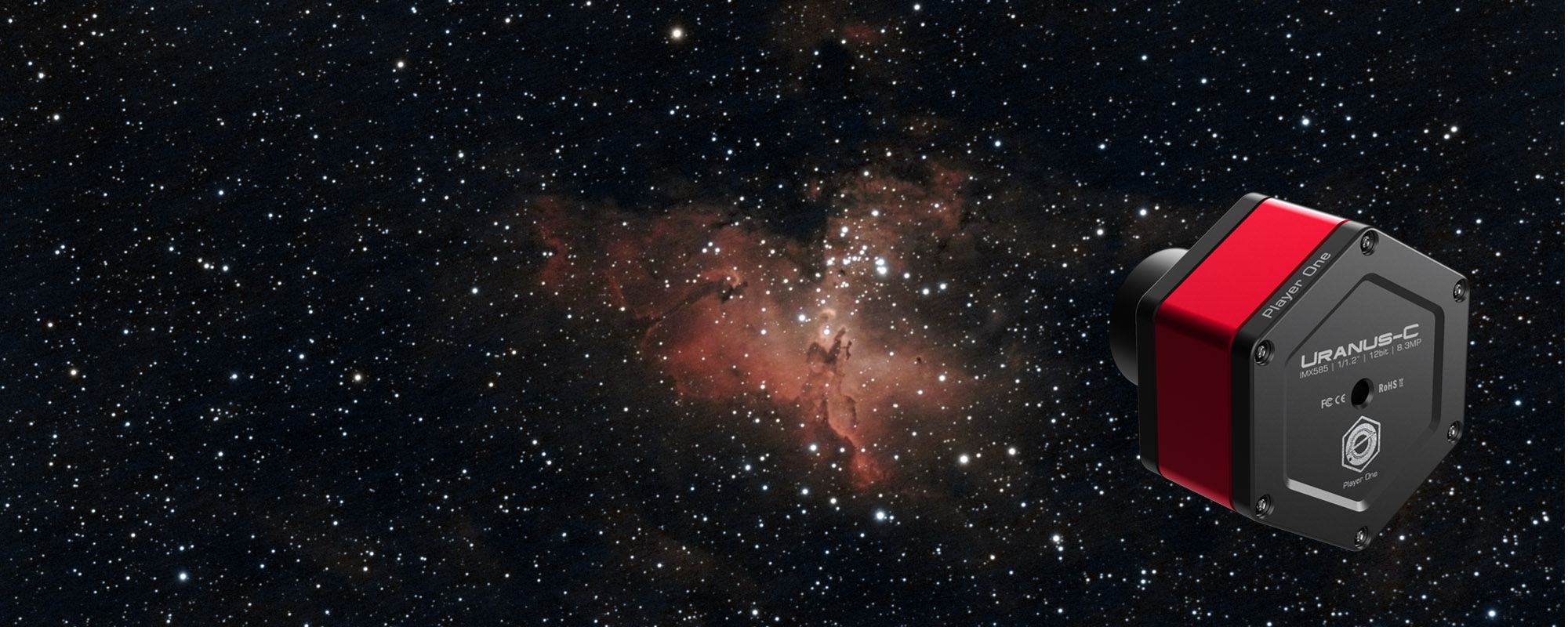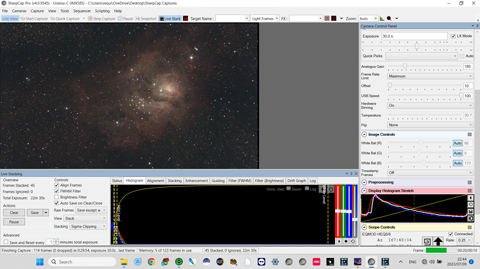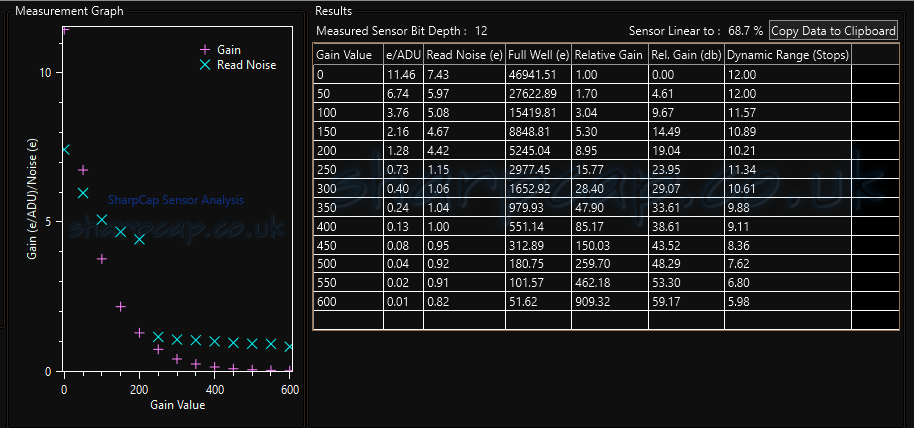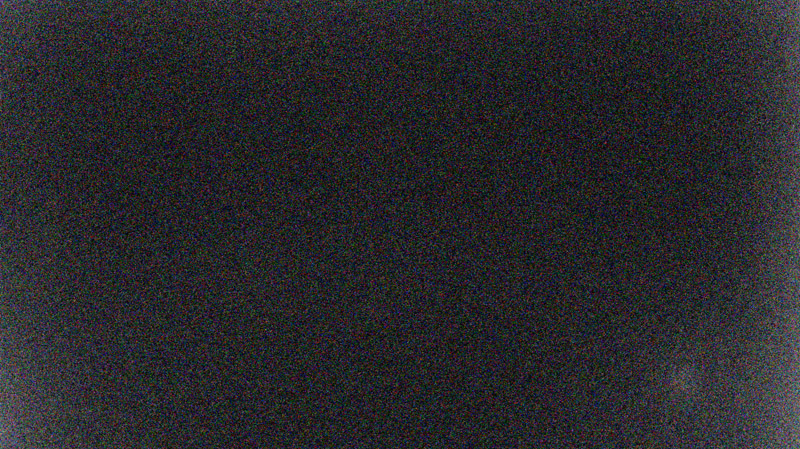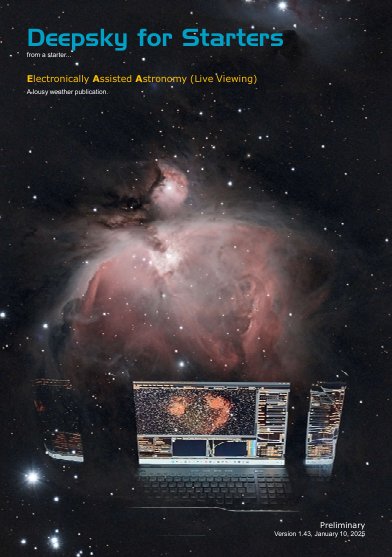Equipment Review (Preliminary)
Player One Uranus-C
Purchase price: USD 400
Dealer: Player One Astronomy
Conclusion: Great for planetary, EAA and deepsky imaging
Please appreciate that this review reflects personal impressions and views.
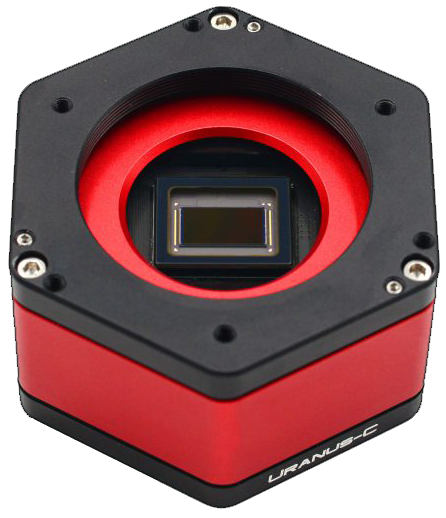
A camera around the Sony IMX585 image sensor is an economical entry to both deepsky and solar system imaging. Although specified a "planetary" camera by all manufacturers, this sensor produces amazing images of deepsky objects either by means of EAA or 'serious' astrophotography. This review picks the Uranus-C from Player One Astronomy while IMX585-powered astronomy cameras are also provided by ZWO, QHY and Svbony.
It is not only a 'planetary camera' as advertised but also a deepsky and EAA camera (multi-purpose) with an attractive price tag. Player One's hexagon shaped CMOS camera sports a 1/1.2" sensor with a total of 3840 x 2180 pixels (8.3 megapixels), each 2.9µm square, arrayed on an area of 11.2 x 6.3mm. The camera convinces with 91% relative quantum efficiency (QE) and 47k e full-well capacity, a.k.a. 'well depth・ which is 3 times improved over the previous model, the IMX485. The flange back to the sensor is 12.5mm.
Inherent to the large image size at maximum resolution, the transfer rate is 47fps (frames per second). This requires a fast control computer with USB-3.x and an SSD disk, but on the other hand, the camera is equipped with 256 megabyte DDR3 buffer memory which temporarily buffers image frames for slow control computers in an attempt to avoid dropping of frames. At HD resolution (1920 x 1080 pixels) the frame rate reaches speedy 187fps outperforming cameras with native HD-size sensors. The employed IMX585 sensor is highly responsive to near-infrared, opening gates to additional applications. The sensor has a dynamic range of 88dB in a single exposure. The Uranus-C also provides DPS (dead pixel suppression) function which cosmetically improves images and also incorporates passive cooling which helps keep sensor temperature low though way not as low as active cooling. The Uranus-C is free of 'Amp-Glow' even after 300 seconds exposure time. Readout noise is below 1e at gain above 250.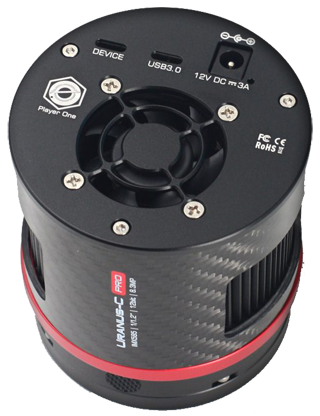 With an optional T2 to C-mount adapter and an ultra-wide lens, the Uranus-C is ideal for all-sky monitoring. Since the flange distance is 12.5mm for CS lenses, a 5mm thick, Ø25.4mm extension is required for a C lens (flange distance 7.5mm). The IMX585 sensor may be too large for some wide angle C or CS lenses.
Eyeing at solar imaging in hot summers, Player One offers an optional air-cool system, ACS, with a magnetic levitation mute fan and a heat sink. A dial controls the speed of the fan. Released in May2023, the Uranus-C Pro (right) comes with 2 Stage TEC Cooling to support extended exposure times with 40°C below ambient. It also sports an inbuild anti-dew heater. If you can lay on another 200 USD the Pro version is the far better choice for long exposure deepsky imaging. This review discusses the uncooled plain version only.
With an optional T2 to C-mount adapter and an ultra-wide lens, the Uranus-C is ideal for all-sky monitoring. Since the flange distance is 12.5mm for CS lenses, a 5mm thick, Ø25.4mm extension is required for a C lens (flange distance 7.5mm). The IMX585 sensor may be too large for some wide angle C or CS lenses.
Eyeing at solar imaging in hot summers, Player One offers an optional air-cool system, ACS, with a magnetic levitation mute fan and a heat sink. A dial controls the speed of the fan. Released in May2023, the Uranus-C Pro (right) comes with 2 Stage TEC Cooling to support extended exposure times with 40°C below ambient. It also sports an inbuild anti-dew heater. If you can lay on another 200 USD the Pro version is the far better choice for long exposure deepsky imaging. This review discusses the uncooled plain version only.
Response & Efficiency
The full spectrum luminance without external optional filters is remarkably high, however, for imaging the moon and planet in color an UV/IR-cut filter is indispensable since the infrared portion washes out colors and is not focused in the same plane (some reflectors actually do focus both correctly).
On the other hand, in order to make full use of the calming effect of infrared at poor seeing an IR-pass filter is required for infrared imaging. The suitable opening wavelength depends on the telescope's aperture and seeing condition, usually between 640nm and 850nm while the camera's response drops sharply beyond 850nm. In most cases a 640nm filter is the best choice whereas a 850nm filter will severely compromise details and frame rate. Around 850nm is benefitial for instance for imaging the clouds over Venus and the gas planets Saturn and Jupiter.Red peaks at 655nm near to Hydrogen Alpha (Hα = 656.28nm) and note the impressive response to near-infrared as far as 800nm plus the large overlappings of blue, green and red curves which contribute to clear colors, and yes, there is green color in space though not a lot. The Dumbbell Nebula, M27, is a fine example.
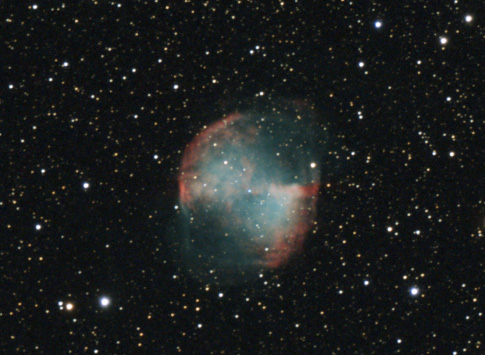 The Dumbbell Nebula captured with Uranus-C.
The Dumbbell Nebula captured with Uranus-C.
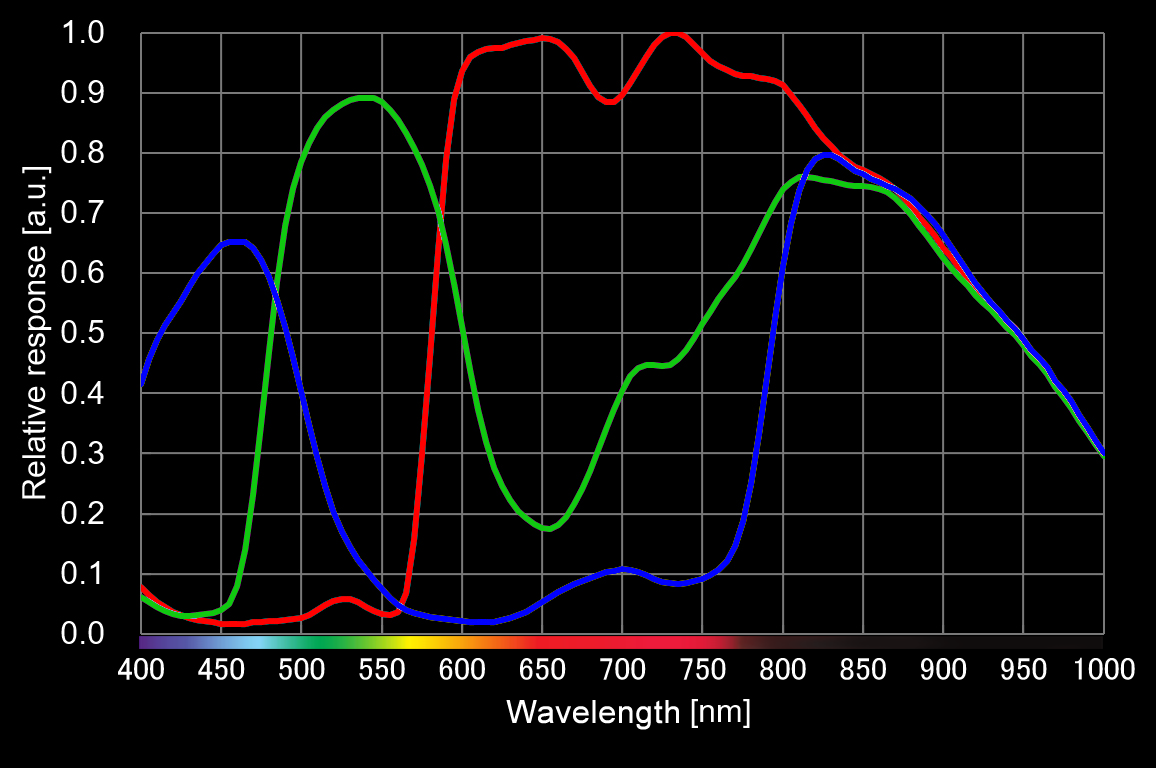 Relative response curve of the IMX585 (Sony Corporation).
Relative response curve of the IMX585 (Sony Corporation).
Performance
Of primary interest are the second and fourth plots from the top, namely Readout Noise (RN) and Dynamic Range (DR). RN drops significantly at gain 210 while DR peaks at gain 210 as well. This indicates that the 'starting point' for keeping RN low is at gain 210, while about the same applies to the gain which fully uses the available dynamic range ('unity gain'). RN is impressively low from gain 210 all the way up to gain 550, however, there is hardly any benefit chosing higher gain, just more saturation issues as dynamic range would decrease with higher gain. The camera's automatic High Conversion Gain, HCG, function to reduce RN at high gain kicks in at gain 210, too.
The dynamic range of 11.891 at gain 210 corresponding to nearly 12 stops is deeply impressive as it hardly differs from zero gain. A high dynamic range is crucial for image quality. For instance, at 12 stops the number of provided brighness levels is 4096 (12-bit). The camera can save both 8-bit or 16-bit images, while the upper 4 bits in 16-bit files are ignored. For many applications 8-bit color is considered sufficient. It is a safe choice to set gain to, say, 220 and adjust exposure time accordingly so as to achieve best exposed light frames. At lower gain the RN starts at 4e- and rises further. This is a real problem for short exposure EAA tasks. There is hardly any benefit from higher gain, just more saturation issues as dynamic range would decrease with higher gain. Note that the sweet spot gain is not the same throughout all cameras housing the IMX585 sensor and is also controlled by camera driver software. The maximum full-well capacity won't be reached in practical applications unless readout noise and gain are negligible factors. Gain is given in units of 0.1dB in that for instance gain 220 corresponds to 22dB gain.
The Uranus-C is best suited for live stacking (EAA) with capture software such as SharpCap 4.x Pro. The camera's pixel- and chip sizes are a fine match with small refractors with respect to image scale and field of view. This combination nicely frames popular bright nebulae such as the Lagoon, Omega, Trifid, Eagle, Dumbbell, Orion, etc.
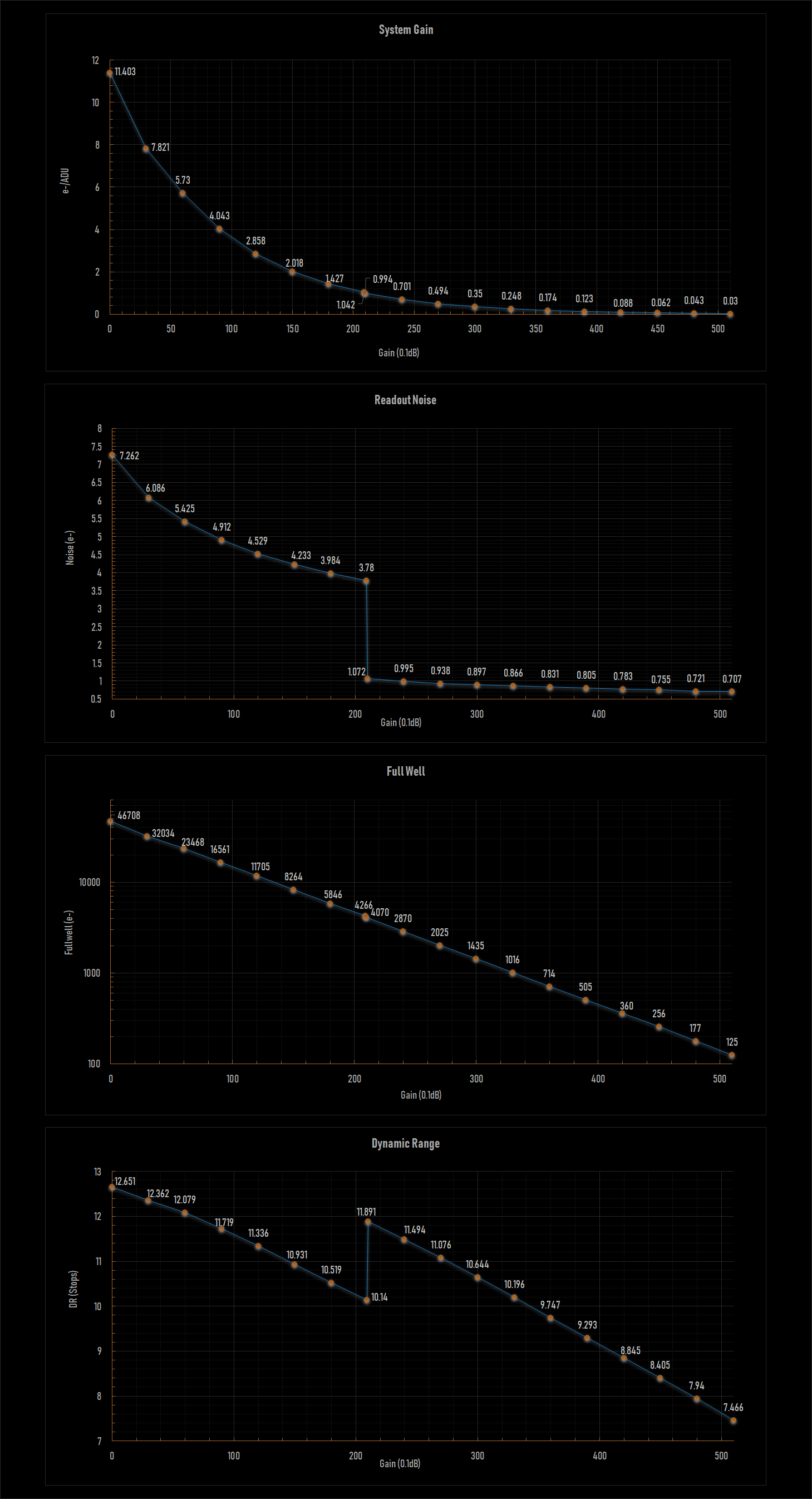 Relative response curve (QE) of the IMX585.
Relative response curve (QE) of the IMX585.
Amplifier Glow
The exposure time of the dark image in raw16 is 300 seconds at gain 0 and 40°C sensor temperature. It is evenly dark gray and free of glow. The image also attests working Dead Pixel Suppression.
SharpCap Analysis
The analysis result as provided by SharpCap 4.1 Pro is largely in agreement with the performance graphs which are provided by the camera manufacturer. The analysis result attests that a gain near 200 (20dB) is close to the 'sweet spot' of 210 in terms of dynamic range and readout noise, however, only 10% of the full well is used. Test results can differ slightly when repeating tests which is largely related to the uniformity of illumination during the analysis, the more uniform the more accurate the results.
When testing yourself, please be sure to have the latest camera driver From Player One installed.
Cooling
Passive Cooling like that of the Uranus-C is heat dissipation implemented analog to a heat sink glued on a semiconductor chip, such as a CPU. The camera's sensor is contacted with the housing via a thermal conductor pad.
Several tests in mid summer revealed that the difference between sensor temperature and 28°C ambient is 4°C on average speaking for the welcome efficiency of passive cooling. Not withstanding, the sensor temperature is composed of the influence of ambient and electrical upheating of the sensor chip in that electrically powered active cooling to typically 40°C below ambient can make a tremendous difference in terms of noise and hot pixel suppression.The optional ACS is of some help but it can't get the sensor any cooler than ambient which is not necessary for planetary and lunar work as the excellent thermal behaviour does not require cooling for millisecond range exposure times.

Optional Air Cooling System
Temperature Dependence
Out of curiosity, two frames 120 seconds each at gain 220 (near unity gain) during sensor temperatures of 21°C (left) and 36°C (right) with a black dust cap over the nose piece. Captured and stretched with SharpCap 4.1 Pro. the ambient temperature was 27°C. Though the camera activates its dead pixel supression, DPS function, "Hot pixel removal only" under Preprocessing was engaged and sensitivity set to the maximum of 25 for both frames.
![]()
Deepsky Examples
All images taken with the Uranus-C and an UV/IR-Cut filter on a TS-71SDQ quadruplet apochromat with Ø71mm aperture and 450mm focal length a combination resulting in a field of view of 1.42° x 0.8° (almost three full moons wide minus cropped area) and an image scale of 1.33 arc seconds per pixel. Magnification is about 35x. Captured with SharpCap 4.x Pro in Live Stacking mode and saved as FITS for further processing. Please appreciate that weather and seeing conditions varied.
Widefield Deepsky Examples
All images taken with the Uranus-C with a dual-band filter on a Samyang prime lens with 135mm focal length a combination resulting in a field of view of 4.65° x 2.62° (minus cropped area) and an image scale of 4.426 arc seconds per pixel. Magnification is about 11x. Captured with SharpCap 4.x Pro in Live Stacking mode and saved as FITS for further processing. Please appreciate that weather and seeing conditions varied.
 Lobster or War & Peace Nebula (NGC 6357) and Cat's Paw (NGC 6334) nebulae in Scorpius, at f2, 129 x 60 sec gain 220.
Lobster or War & Peace Nebula (NGC 6357) and Cat's Paw (NGC 6334) nebulae in Scorpius, at f2, 129 x 60 sec gain 220.
Full Screen
Solar System Test Images
All images taken with the Uranus-C and an UV/IR-Cut filter.
Further samples in the gallery...
Pros
- Extremely high near-infrared sensitivity
- Excellent readout noise performance
- Good thermal behavior
- Dead pixel detection
- High frame rate at HD resolution.
- Internal buffer memory
- Tilt adjustment screws
- Optional fan cooling possible
- Light weight, solid construction
- Easy sensor access for cleaning
- Quarter-inch tripod thread
Cons
- Requires ASCOM, however ASCOM is usually installed on every PC running astronomy software.
Verdict
This camera has an attractive price tag and performs formadibly not only as a planetary camera but also for deepsky imaging, either EAA (live viewing) or 'serious' astrophotogaphy. Thermal characteristics and dynamic range are impeccable for its class even with only passive cooling. Its sensor size being four times the area of HD sensors is ideal for lunar mosaics. Mated with lenses or refractors up to, say, 500mm focal length almost all popular nebulae are in the field of view. Light-weight and small it is ideal for travel setups with trackers. Once you "played" with it you won't want to miss it as your work horse or in your camera collection.
